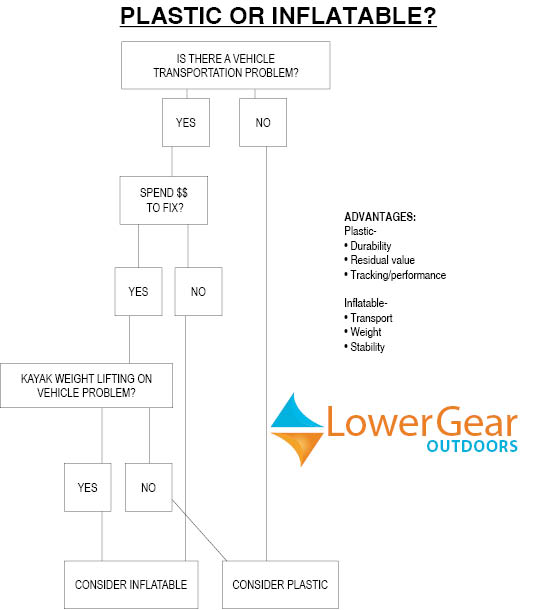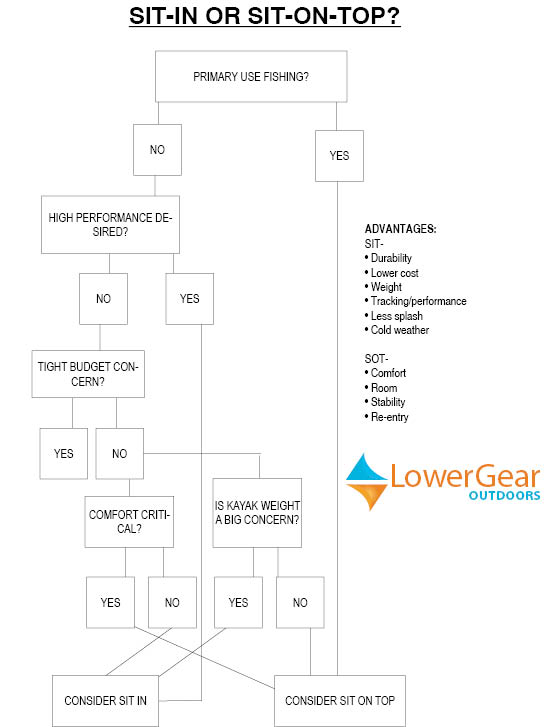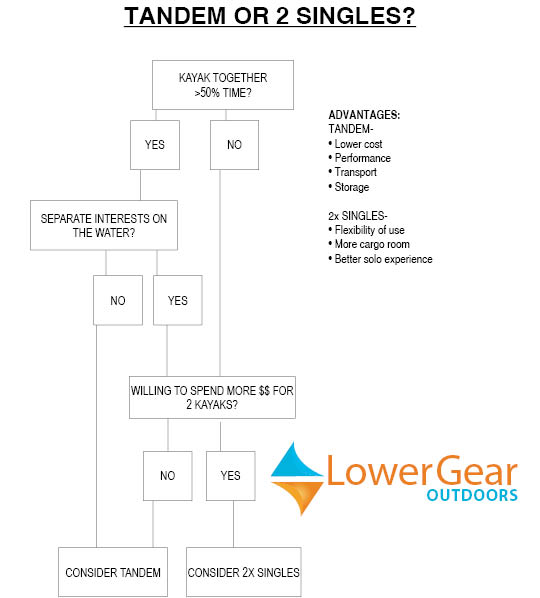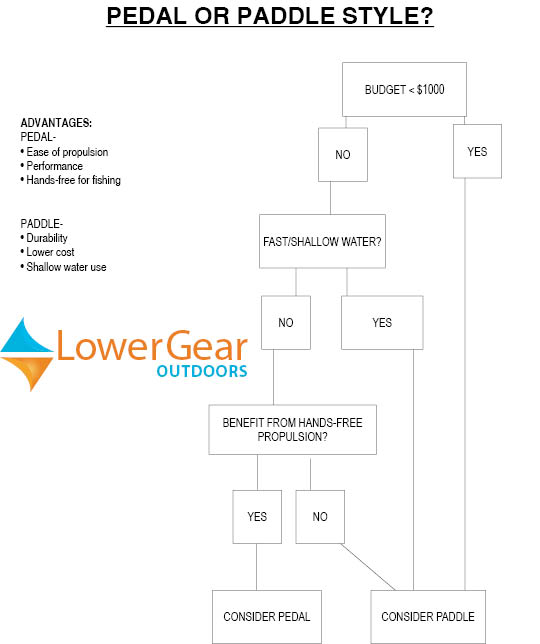0
No products
To be determined
Shipping
$0.00
Total
This item added to your cart. Calculate any delivery cost at next step.
Quantity
Total
There are 0 items in your cart. There is 1 item in your cart.
Total products
At our stores in Arizona, we feature all kinds of kayaks - basic sit-in and sit-on-tops; "luxurious" and stable fishing kayaks; fast sailing kayaks, and all kinds of models for one, two or more riders. See a sampling of the many kayak models and brands we sell. This means you have so many options to choose from, you might fall into the "paralysis by analysis" rabbit hole. We'll help you get past that and get out on the water!
Plastic or inflatable?
The hull structure comes into play if you have restrictive means of transportation or storage. If you cannot raise a heavy plastic kayak on top of your car roof, and you don't want to deal with a trailer or truck, then inflatable may be the route to go. If you are highly concerned about durability, and want the best performance, you'll want plastic and decide how you want to transport it. Inflatables are much stronger than even just a few years ago, but will never be as durable as plastic. Plastic models tend to track - stay straight when under way - than inflatables. Inflatables are the most popular option for those in an RV lifestyle, apartment dwellers, or those looking for the lightest weight options. Click on the image below to follow a simple flow chart to see what might be best for you.
 Click to enlarge
Click to enlarge
Sit-on or sit-on-top?
Sit-in models are the classic kayak style where the operator is seated down inside the hull of kayak, separated from the water only by the thickness of the hull bottom. Typically the shell of kayak covers the legs, minimizing splashing of water on to the operator. Sit-ins are generally lighter, more nimble, and more stable once seated due to their low center of gravity. But, sit-ins are hard to re-enter if you fall out; if water gets in the cockpit it has nowhere to go unless pumped or sponged out; and access to stored gear can be troublesome on the water. Sit-ins are the better option for fast currents or long-distance paddling.
Sit-on-top models feature open cockpits, commonly with a hull below the rider that can accessed through hatches for dry storage. The rider sits up higher above the water, making this style more popular with anglers than sit-ins. On-top models are easier to get in to, generally have more readily accessible cargo room, and are much more stable when standing or moving around. You may get wetter in a sit-on, so cold weather kayakers often prefer the sit-in style. Any water that does splash into the cockpit is drained out through scupper holes; the kayak is mostly self-bailing. Click on the image below to follow a simple flow chart to see what might be best for you.
 Click to enlarge
Click to enlarge
Tandem or two singles?
This is a common decision point couples and friends should consider before purchasing. A tandem is generally less money than 2 similar-quality singles, but heavier and less flexible in travel. Both of you in one kayak have to go to the same place at the same time of course! Singles allow more travel flexibility, collectively have more cargo room, but are more expensive and sometimes more trouble to transport. Two people in a tandem usually offers better performance, as they are not all that much heavier than one single, but have two people powering it. However, tandem paddle kayaks do require somewhat synchronized paddle strokes for better performance - we call them "divorce boats". Click on the image below to follow a simple flow chart to see what might be best for you.
 Click to enlarge
Click to enlarge
Pedal or paddle kayak?
Hobie came out with the first widely distributed pedal-drive kayak models more than 20 years ago, and now most major brands have a pedal-drive option in their line-up. Assuming your legs are stronger than your arms, most riders find the pedal-drive models to be easier to propel through the water. They are also usually easier to control direction with an integrated rudder and steering handle setup, rather than depending on paddle alignment for direction. Pedal kayaks are mostly found in sit-on-top hulls.
Traditional paddle-propulsion kayaks are less money, have fewer maintenance concerns and can be either sit-in or sit-on-top styles. Paddle styles are better for shallow water, but most pedal drives can be removed for traditional paddling when needed.
Pedal drives offer a great advantage for anglers since the rider is hands-free and can focus on casting.
 Click to enlarge
Click to enlarge
Plastic or inflatable?
The hull structure comes into play if you have restrictive means of transportation or storage. If you cannot raise a heavy plastic kayak on top of your car roof, and you don't want to deal with a trailer or truck, then inflatable may be the route to go. If you are highly concerned about durability, and want the best performance, you'll want plastic and decide how you want to transport it. Inflatables are much stronger than even just a few years ago, but will never be as durable as plastic. Plastic models tend to track - stay straight when under way - than inflatables. Inflatables are the most popular option for those in an RV lifestyle, apartment dwellers, or those looking for the lightest weight options. Click on the image below to follow a simple flow chart to see what might be best for you.
 Click to enlarge
Click to enlargeSit-on or sit-on-top?
Sit-in models are the classic kayak style where the operator is seated down inside the hull of kayak, separated from the water only by the thickness of the hull bottom. Typically the shell of kayak covers the legs, minimizing splashing of water on to the operator. Sit-ins are generally lighter, more nimble, and more stable once seated due to their low center of gravity. But, sit-ins are hard to re-enter if you fall out; if water gets in the cockpit it has nowhere to go unless pumped or sponged out; and access to stored gear can be troublesome on the water. Sit-ins are the better option for fast currents or long-distance paddling.
Sit-on-top models feature open cockpits, commonly with a hull below the rider that can accessed through hatches for dry storage. The rider sits up higher above the water, making this style more popular with anglers than sit-ins. On-top models are easier to get in to, generally have more readily accessible cargo room, and are much more stable when standing or moving around. You may get wetter in a sit-on, so cold weather kayakers often prefer the sit-in style. Any water that does splash into the cockpit is drained out through scupper holes; the kayak is mostly self-bailing. Click on the image below to follow a simple flow chart to see what might be best for you.
 Click to enlarge
Click to enlargeTandem or two singles?
This is a common decision point couples and friends should consider before purchasing. A tandem is generally less money than 2 similar-quality singles, but heavier and less flexible in travel. Both of you in one kayak have to go to the same place at the same time of course! Singles allow more travel flexibility, collectively have more cargo room, but are more expensive and sometimes more trouble to transport. Two people in a tandem usually offers better performance, as they are not all that much heavier than one single, but have two people powering it. However, tandem paddle kayaks do require somewhat synchronized paddle strokes for better performance - we call them "divorce boats". Click on the image below to follow a simple flow chart to see what might be best for you.
 Click to enlarge
Click to enlargePedal or paddle kayak?
Hobie came out with the first widely distributed pedal-drive kayak models more than 20 years ago, and now most major brands have a pedal-drive option in their line-up. Assuming your legs are stronger than your arms, most riders find the pedal-drive models to be easier to propel through the water. They are also usually easier to control direction with an integrated rudder and steering handle setup, rather than depending on paddle alignment for direction. Pedal kayaks are mostly found in sit-on-top hulls.
Traditional paddle-propulsion kayaks are less money, have fewer maintenance concerns and can be either sit-in or sit-on-top styles. Paddle styles are better for shallow water, but most pedal drives can be removed for traditional paddling when needed.
Pedal drives offer a great advantage for anglers since the rider is hands-free and can focus on casting.
 Click to enlarge
Click to enlarge

